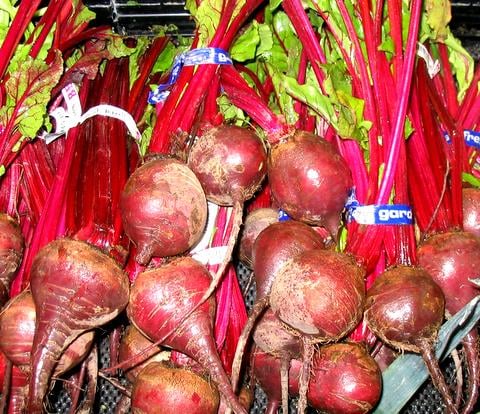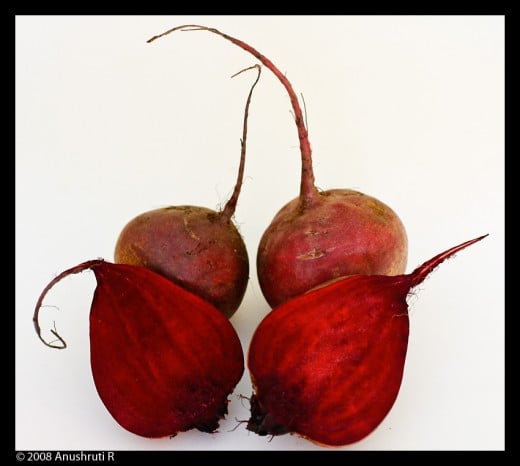What are the Benefits of Beet(root)
Where did the Beet Originate
By all accounts the beet we eat today was cultivated from the sea-beet of the Mediterranean area. Though there is little written evidence, archeological digs indicate the beet was eaten (leaves only) as far back as 2,000 BCE.
Documents mentioning the growing and eating of beets from at least Mesopotamian times where the beet is mentioned as far back as 800 BCE. Current evidence suggests that Mesopotamians ate the leaves not the root, thus they ate chard.
Recipes from first century (roughly 43 CE) Roman show that the root was being consumed by this time.
Beet Sugar
Sugar has been extracted from beets since the mid seventeen hundreds based on the research of Andreas Marggraf. Over the decades the sugar content of this variety of beet has risen from just under 2% to over 6%. The sugars contained in these beets is identical to the sugar extracted from sugar-cane.


Beet Nutritional Value
Beets, the root in particular, is high in nutritional value. Three and a half ounces contain 9.5 grams of carbohydrate, almost 7 grams of sugar, 3 grams of dietary fiber, less than on fifth gram of fat and 2 grams of protein.
That same serving contains less than ten percent of B1, B2, B3, B5, B6 and B9 as well as vitamin C. Included in the nutritional profile are calcium, iron, magnesium, phosphorus, potassium and zinc.
Additionally beet contains antioxidants called betalains which can be readily seen by the color of the beet itself. In fact beta, from betalain is Latin for beet.
These antioxidants have been studied for their anti-cancer properties and are also, oddly, used as dyes in a wide variety of foods.
Health Benefits of Beet
Beetroots are rich in the nutrient betaine which has been found very important to cardio-vascular health. Betaine works along with folic acid, and vitamins B6 and B2 to reduce the effects of homocysteine. This molecule has been implicated the weakening of cell walls.
Rodent studies also indicate that betaine may improve liver function by reducing fatty deposits in the liver.
Finally, betaine has been shown to reduce high blood pressure. The journal Hypertension published by the American Heart Association found that drinking sixteen (16oz) ounces (500 ml) of beetroot juice reduced blood pressure within one hour.
This reduction was even more pronounced after three to four hours and the effect was still detectable up to twenty-four hours after drinking the juice.
Choosing Beets
When shopping for beets buy as much of the whole plant as possible. Since the root is a tuber it will be very hard to tell if it's fresh looking at just the root. However, the stems and leaves should not be wilted or brown. The visible stalks should be green or red and the leaves still green and succulent looking.
Other Uses of Beet
Betaine is also used as a food grade dye in tomato paste, jams, jellies, ice-cream, and breakfast cereal. It is used as a colorant in organic fruit juices to improve that hue without using artificial colorants.
Betaine does not readily break down (metabolize) in the human body so an excess consumption of beet, beet-juice or food colored with Betaine could cause an alarming, though completely safe, change in the color of the stool or urine.
Folk Uses of Beets
The ancient Romans felt that beets were both a fever reducer and laxative. Rome also considered the root an aphrodisiac.
Hippocrates touted the effectiveness of beet leaves as a wound dressing.
In the middle-ages beet was a cure for indigestion and as a blood purifier.
Eating Beets
Recipes will follow, but generally speaking the entire plant is edible. This includes the leaves, stalks, and roots.
Steamed or boiled leaves can function as a decent substitution for spinach and the root can be roasted, boiled, fried, pickled or eaten raw.
Cultivating Beets
Beet grows best in full sun in well-drained soil. It prefers loamy/sandy soil with a neutral Ph. It is a fast growing plant that does well in colder climates. Beets should be harvested in spring, summer and fall.
Less than Usual Beet Recipes
My Personal Favorite
Raw!
- Use the guide above to purchase your beets.
- Trim off the tap-root and stems.
- Peel with a vegetable peeler.
- Course grater into a bowl of cool water.
- When ready to use grab a handful and shake off excess water.
- Use as a salad topping.
Raw beet has a very distinctive flavor and will add an earthy yet sweet note to your salads.
Beet and Apple Salad
Ingredients
- 1 Pound uncooked beets peeled and grated
- 1 Pound Granny Smith apples peeled and grated (another tart apple works well here too)
- 1/2 Pound celery root, peeled and grated (or use celery stalk)
- 2 Scallions, diced
- 4 ounces apple juice
- 2 ounces sherry vinegar
- 4 ounces olive oil
- 2 bunches picked watercress
- Salt and pepper
Directions
- Mix beets, apples, celery root and scallions together.
- Season with salt
and pepper and set aside.
- Whisk together apple juice, vinegar and whisk
in olive oil slowly.
- Pour mixture over beets cover tightly and
refrigerate for 3 hours.
- Remove from refrigerator and toss in the watercress and serve.
Roasted Beet Salad
Ingredients
- 3 or 4 fresh beets, sliced, rinsed and drained
- 1 1/2 Cups crumbled Feta cheese
- 1/2 Cup pitted ripe olives
- 1/4 Cup chopped fresh dill
- 1/2 Cup extra virgin olive oil
- 1/4 Cup rice wine vinegar (Japanese is best)
- Salt, pepper and garlic powder, to taste
- Dash hot sauce
Directions
You can do this on the grill too if you like.
- Remove the broiler tray from oven and coat with nonstick cooking spray.
- Preheat broiler.
- Once to temperature place the beets on coated broiler tray and place under hot broiler.
- Turn every 2 to 3 minutes until edges start to brown. This could take ten to twelve minutes.
- Remove
beets from oven and allow to cool.
- Mix remaining ingredients with cooled beets. Toss and serve.
Beet Sauce
Try this on fried fish or mashed potatoes.
Ingredients
- 1 Pound of red beets including stems and leaves
- 1 Cup of water
- 1 1/2 Tablespoon of soy sauce
- 1 Tablespoon balsamic vinegar
- Salt and pepper to taste
Directions
- Trim beets, leaving about 1 inch of stems attached.
- Wrap beets tightly in foil and in a baking
pan roast in middle of oven until tender, about 1 hour.
- Unwrap beets carefully. When beets are cool enough to handle, slip off skins and stems.
- In a blender or food processor puree beets with water,
soy sauce, vinegar, and salt and pepper to taste until smooth.
- Keep the sauce warm to serve over your food of choice.










